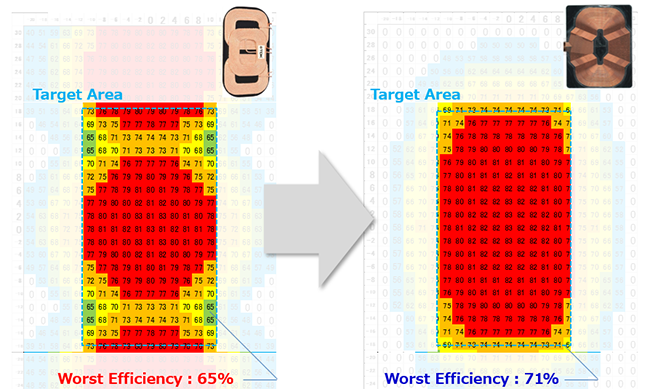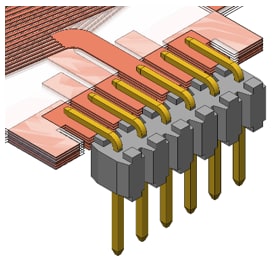Introduction to TDK’s New MP-A28 Wireless Power Pattern Coil

Contents
- Background
- MP-A28 Pattern Coil Features and Benefits
- Thin
- Weight reduction
- Electrical parameter consistency
- Intricate coil patterning designs
- Reduced part count
- Robust automotive design
- Ease of lead termination
- Integrated NFC antennas
- Optional EMI screen - Product Information
- Contact Information
- Related Links
Background
TDK has a long history of utilizing copper plating processes to construct metal coil structures used within power inductors and has now leveraged this proven mature technology and applied it to wireless power coils. TDK’s TFM power inductor series has used a similar high aspect plating (HAP) copper technology to increase the coil pattern’s cross-sectional area to reduce direct current resistance (DCR). From this vast experience, the patterning and plating processes have been improved to the point where they can now be used in wireless power transmit (Tx) coils that traditionally are required to use litz wire.
The Qi approved MP-A28 coil consists of 3 key innovative areas:
- 1) a revolutionary and patented coil pattern design
- 2) an additive copper plating process applied on a carrier PET film and
- 3) a “wet process” high permeability, high magnetic flux density saturation (Bs) value magnetic shield upon which the coil structure is attached.
The flexible coil patterning capability allows for better control and shaping of the magnetic field (H), thus concentrating the magnetic flux (ɸ) where it optimizes magnetic coupling with the Rx device and efficiency. The patterning allows for the charging efficiency “peaks” and “valleys”, typical of multiple coil structures, to be reduced. The patterning also reduces/removes the low efficiency (“dead”) areas around the edges of the complete coil.
The coil plating process is as an additive process where copper is plated on a designated location. This differs from printed circuit boards (PCBs) and/or flex printed boards (FPCs) where a solid copper sheet is etched and only leaves the desired copper pattern as a subtractive process.
The shield “wet process” uses Mn-Zn ferrite material and is applied as a wet “slurry” to a carrier film to a thickness of 0.3 mm … though it can be as thin as 0.1 mm. After being applied to the film the ferrite is then sintered and pre-cracked.
For the dominant low power wireless charging standard by the Wireless Power Consortium, most of the approved standard transmit (Tx) coils have historically been wire wound based. More specifically, litz wire has been used. This multi-strand wire type, with its greater copper surface area, is used to reduce skin effect losses which contribute to higher alternating current resistance (ACR) at the operating frequency. Because of this phenomenon, the MP-A28’s pattern coil also utilizes a patented multi-layer stacking structure to help mitigate AC copper losses.
MP-A28 Pattern Coil Features and Benefits
TDK’s new pattern coil technology implements various new material processes and construction techniques to achieve a wide spectrum of features and benefits to the end-user. Some of the key benefits being:
Thin – the tightly controlled copper plating thickness, available from 5 um to 150 um, along with a wet process 0.3 mm Mn-Zn ferrite shield, allow for a total coil assembly thickness of 0.76 mm for MP-A28 15W Qi compliant transmit coils. This results in thinner and lighter over all charger designs utilizing the MP-A28 coil assembly.
Having a thin copper coil pattern also has a system performance benefit. Magnetic coupling (K) is impacted by the physical distance between the transmit (Tx) and receive (Rx) magnetic shields. With the ultra-thin coil pattern, this results in the MP-A28 coil shield being closer to the charge surface, closer to the Rx device and thus improving magnetic coupling and efficiency.
Weight reduction – especially now as electric vehicle makers try to extend their battery charge and vehicle range, weight reduction continues to be a major talking point. With TDK’s MP-A28 coil, the thinness capability of the wet process/higher permeability (µ’) material, allows for a Tx coil weight reduction while still maintaining the required charging performance.
Electrical parameter consistency – The MP-A28 coil uses a photo mask/electroplating process, which yields air coils with less than 0.5% electrical variation. The MP-A28 coil also uses a co-planar structure for both the copper coil patterning and the ferrite shield. All of these ensure that the complete coil’s inductance (Ls) and resistance (Rs) values do not vary as they do with wire wound coils. Wire wound coils have insulation thickness variation, turn to turn winding variations in terms of co-planarity, and wire tautness control issues on the wire during winding which changes the magnetic length and respective Ls value.
Intricate coil patterning designs – TDK’s highly precise copper additive process creates opportunities to design irregular shaped coil patterns that help reduce “dead zones” where the charging efficiencies are diminished or completely not working as with traditional wire wound coils. The innovative MP-A28 coil pattern also allows the magnetic field (H) to be shaped and the magnetic flux (ɸ) to be focused in the regions of best charging. This also helps keep the magnetic field away from any neighboring metal objects and limits the magnetic flux getting into other areas of the charging device [phone].
Magnetic flux distribution for Tri-Coil of wire-wound type
Magnetic flux distribution generated by MP-A28 Coil
With the more uniform magnetic field, an improvement in efficiency is also achieved in the event of misalignment between the Tx coil and the Rx coil within the to-be-charged device.
WPC MP-A13 Coil Efficiency Map
WPC MP-A28 Coil Efficiency Map
Additionally, the new MP-A28 coil consists of multiple traces in parallel on multiple layers to increase each effective turn’s surface area to minimize copper trace alternating current (AC) skin effects that increase the AC resistance (ACR) which subsequently increases wire losses and temperature rise and therefore, reduce efficiency.
Reduced part count – the Qi complaint MP-A28 is designed as a single charge coil structure that is sized and shaped to provide better coverage than tri-coil configurations. Since there is only a single coil, many of the duplicate electronic parts associated with the tri-coil’s structure can be eliminated and thus reducing part count and BOM costs. The MP-A28 requires only one driver, one switch and one resonant capacitor bank (Cs) and may also eliminate thermistors, if used.
Robust automotive design – automotive applications have stringent requirements not imposed on other applications and end markets. The pre-cracking process of the thin ferrite shield ensures that no additional cracking, and thus loss of performance, can occur in the event of unwanted events such as: mechanical shock, vibration, impacts, thermal shock, etc.
Ease of lead termination – due to the MP-A28 coil’s flat trace that is created by the patterning process, the coil is available with either copper leads or it can be supplied with connector/header pins to provide easy assembly when connecting to the main PCB containing the charging circuit’s components. TDK attaches these pins using a non-solder ultra-sonic welding process. This eliminates the need for thru-holes, soldering, de-soldering during rework, etc., as required when using wire wound coils.
Integrated NFC antennas – A major advantage of copper plating on a carrier film is that additional independent coil patterns can also be integrated on the same carrier layer. One common additional coil used in wireless charging transmit devices are near field communication (NFC) antennas. Since electro-plating is independent of the amount of patterning required, adding the NFC coil to the existing wireless power coil structure comes at a minimal cost. The NFC antenna then uses the existing ferrite shield … eliminating the need for dual shields and the corresponding cost. This reduces the required area needed to implement both technologies, as they are usually placed side by side, as well as reducing weight.
Optional EMI screen – The MP-A28 also has an optional EMI metal mesh screen that is a separate 30 um thick layer. This screen is intended to help meet the automotive CISPR 25 requirements. By placing the screen over the MP-A28’s coil pattern and then electrically grounding it, an effective and light weight EMI noise suppression solution can be obtained. The impact of adding the EMI screen to the stack-up is less than a 1% efficiency decrease.
Product Information
| WPC Part Number | MP-A28 |
|---|---|
| TDK Part Number | WCT38466-N0E0SST101 |






